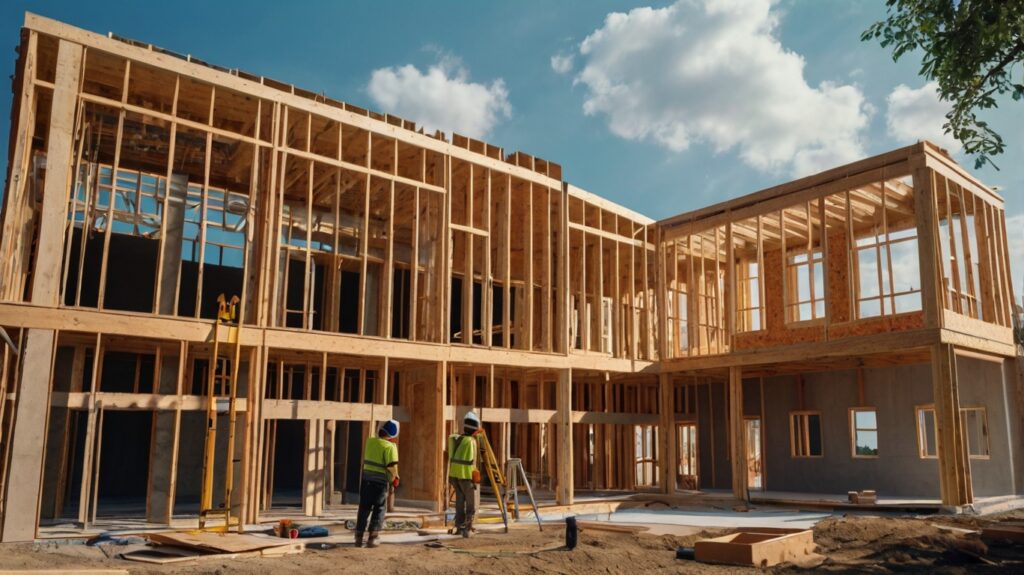- Types of Insurance Policies for Home Builders
- Coverage for Material and Structural Risks
- Liability Protection for Contractors
- Endorsements for Custom Projects
- Regulatory and Code Compliance
- Factors Affecting Premiums and Deductibles
- Navigating the Claims Process
- Choosing the Right Insurance Provider
- Future Trends in Construction Insurance
Understanding residential construction insurance is essential for anyone involved in home building projects. Residential construction projects come with a variety of risks that must be managed through well-designed insurance policies. These policies help safeguard builders, contractors, and homeowners from unexpected costs and liabilities arising from property damage, personal injuries, or structural failures. Insurance for residential construction covers a wide spectrum of risks, ranging from damage to building materials to personal accident claims. By understanding these elements, builders are better positioned to protect their investments and ensure that projects run smoothly.

1. Types of Insurance Policies for Home Builders
Types of insurance policies for home builders vary based on the nature and scope of the building project. General liability insurance remains a fundamental component of any builder’s portfolio, covering claims related to bodily injury, property damage, or legal liabilities that might arise during construction. Another key policy is property insurance, which protects the physical structure and materials. Builder’s risk insurance is frequently used to shield against damage or loss during construction. This policy typically covers fire, theft, and weather-related damages until the project is completed. Specialized insurance products, such as polluter’s liability and environmental insurance, may also be considered, particularly in projects with increased environmental risks or in regions with strict environmental regulations.
2. Coverage for Material and Structural Risks
Coverage for material and structural risks is among the most critical aspects of insurance in residential construction. Construction projects rely on quality materials and well-executed building techniques. Material insurance covers the loss, damage, or theft of building materials even before they are installed at the construction site. Structural risk insurance, on the other hand, ensures that any defects in design or construction are covered. Often, these policies extend to cover injuries that result from structural failures when the building is in use. The specific terms and limits depend on the insurance provider and the individual policy. Effective coverage means that, should any damage occur, the financial burden is absorbed by the insurance company rather than the homeowner or contractors.
3. Liability Protection for Contractors
Liability protection for contractors is a must-have for anyone involved in residential construction. Whether through general liability insurance or professional indemnity policies, contractors need protection in case of lawsuits emerging from accidents or errors during construction. Liability insurance covers legal fees, court judgments, and settlements, thereby preventing significant financial burdens. When contractors work in collaboration with various subcontractors and suppliers, the potential exposure to liability increases. Adequate liability insurance ensures that even if a mistake is made or if an accident occurs, the financial repercussions are minimized. This protection is particularly important as it also supports more effective risk management throughout a construction’s lifecycle.

4. Endorsements for Custom Projects
Endorsements for custom projects offer additional flexibility to builders who often engage in unique projects. Standard insurance policies might not address the particular needs of high-end or custom-built homes. In cases like these, endorsements or policy riders are used to expand and tailor coverage. Custom endorsements can include provisions for unusual design choices, innovative construction techniques, or the use of rare materials. The added protection ensures that the insurance policy fully reflects the risks associated with custom builds. For example, a custom-built home with rare architectural features and expensive finishes might require higher coverage limits or additional clauses for specific risks. By working closely with insurers and understanding the terms, builders can secure policies that are tailored to their project requirements.
5. Regulatory and Code Compliance
Regulatory and code compliance plays a crucial role in how insurance policies are structured and enforced. Local building codes, zoning laws, and environmental regulations all affect how a residential construction project is insured. Many insurance policies require proof that the construction complies with the relevant codes and standards. This compliance is not only a legal obligation but also an important factor in risk assessment by the insurer. When building codes are updated, or when new safety regulations come into effect, policyholders may be required to adjust their coverage accordingly. Ensuring that construction practices meet regulatory standards minimizes the risk of claims being denied, thereby protecting both the project and the stakeholders involved.
6. Factors Affecting Premiums and Deductibles
Factors affecting premiums and deductibles include the project’s size, location, and the building materials used. Insurance companies use a variety of data points to assess the risk associated with a construction project. Projects located in high-risk areas or those using non-standard building materials may face higher premiums. Additionally, the complexity and duration of a project contribute to the overall cost of insurance. Contractors who have a track record of safe construction practices and low claims are likely to benefit from favorable premium rates. Deductibles are closely tied to the risk profile and determine the amount a policyholder must pay in the event of a claim before insurance coverage kicks in. Balancing the cost of premiums with deductibles is essential to optimize protection while managing operational costs effectively.

7. Navigating the Claims Process
Navigating the claims process can be challenging for builders. Every insurance policy comes with a set of procedures that policyholders must follow in the event of a loss. Documentation forms a crucial part of this process. Comprehensive records, including contracts, receipts, and progress notes, are essential to support a claim. Immediate notification to the insurer is required to ensure that the claim is processed without undue delay. Many policies impose a strict timeline for the filing of claims, so prompt action is important. Effective communication with insurance adjusters is also key. Builders should be prepared to provide detailed information and cooperate fully with investigations. Understanding the technicalities of the claims process ensures that losses are handled efficiently and that operations can resume as quickly as possible after an incident.
8. Choosing the Right Insurance Provider
Choosing the right insurance provider is as important as selecting the right policy. The reputation, financial stability, and customer service quality of an insurer can significantly impact the overall experience when a claim is made. Established insurers with specialized experience in construction and builder’s risk insurance might offer more comprehensive policies suited to the unique needs of residential construction. Additionally, it is prudent to work with providers who understand local building regulations and the regional market dynamics. Requesting recommendations from industry peers and consulting with independent insurance agents can help build a list of qualified insurers. Furthermore, comparing the fine print of various policies is essential to ascertain that key elements such as coverage limits, exclusions, and claim procedures align with project needs.
9. Future Trends in Construction Insurance
Future trends in construction insurance are moving toward customization, technology integration, and sustainability initiatives. As construction practices evolve, insurance products are also adapting to new challenges and opportunities. The increasing adoption of smart building technologies and construction management software allows for enhanced risk monitoring and real-time incident tracking. These innovations not only reduce the risk of accidents but also facilitate more accurate claims assessments. Insurers are also beginning to offer policies that account for environmental risks posed by climate change, such as flooding, wildfires, and severe storms. Moreover, the growing emphasis on green construction practices is prompting insurers to develop specialized products that reward sustainable building practices. Policymakers and insurers alike are expected to continue refining regulations and coverage options to keep pace with a changing industry landscape.

Conclusion
In conclusion, insurance plays a critical role in the residential construction sector by providing essential protections for home builders and contractors. Understanding the specifics of residential construction insurance ensures that builders are adequately prepared to handle risks associated with quality, safety, and legal liabilities. From general liability and property insurance to specialized endorsements for custom builds, each component contributes to the overall stability and security of construction projects. With a clear grasp of coverage options for material and structural risks, liability protection, and the regulatory environment, contractors can make informed decisions when selecting policies. Additionally, being aware of factors such as premiums, deductibles, and claims processes adds a layer of preparedness that is crucial during unexpected events.
Ultimately, choosing the right insurance provider and staying informed about future trends will continue to be pivotal for the success of residential construction projects. As market conditions evolve and new risks emerge, a proactive approach to managing insurance considerations will safeguard investments while ensuring adherence to regulations and industry standards. Builders who invest the time to fully understand and integrate comprehensive insurance solutions into their construction projects are better equipped to navigate challenges, minimize financial exposure, and ultimately achieve project success.
